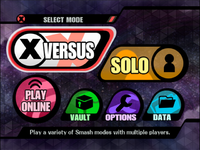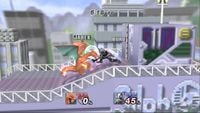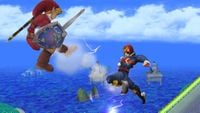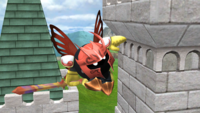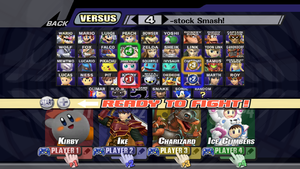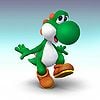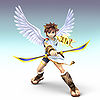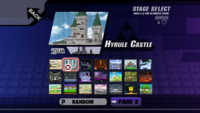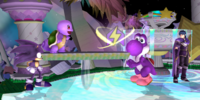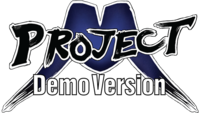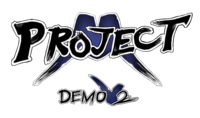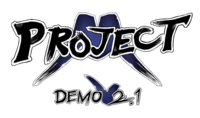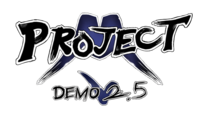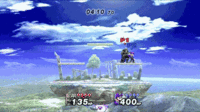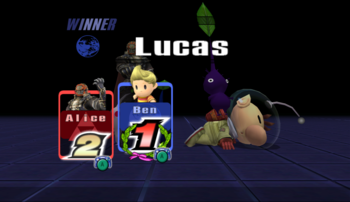Project M: Difference between revisions
(Undid edit by Yoshifan 34567: Already mentioned in the article) |
|||
| Line 84: | Line 84: | ||
*[[Versus Mode|Brawl]] mode is now labeled as "Fight!", Special Brawl is "Special Versus", and all other modes and sections containing "Brawl" are replaced with "Smash" (such as [[Multi-Man Brawl]] being named Multi-Man Smash). | *[[Versus Mode|Brawl]] mode is now labeled as "Fight!", Special Brawl is "Special Versus", and all other modes and sections containing "Brawl" are replaced with "Smash" (such as [[Multi-Man Brawl]] being named Multi-Man Smash). | ||
*Default match type is 4 [[stock]] with an 8-minute timer, and [[Team Attack]] is turned on by default, similar to the settings of usual competitive ''Melee'' matches. | *Default match type is 4 [[stock]] with an 8-minute timer, and [[Team Attack]] is turned on by default, similar to the settings of usual competitive ''Melee'' matches. | ||
*The timer during matches is placed at the top center of the screen rather than at the top right. | *The [[Match Timer|timer]] during matches is placed at the top center of the screen rather than at the top right. | ||
*A time match can be played by just one player, and the default time limit is infinite. | *A time match can be played by just one player, and the default time limit is infinite. | ||
*Altered camera that is capable of zooming out indefinitely and fully rotating around the characters and stages, allowing players to take [[snapshot]]s without any camera restrictions. | *Altered camera that is capable of zooming out indefinitely and fully rotating around the characters and stages, allowing players to take [[snapshot]]s without any camera restrictions. | ||
Revision as of 22:16, April 30, 2016
Project M is a gameplay modification of Super Smash Bros. Brawl designed to make the gameplay more closely resemble that of Super Smash Bros. Melee mainly, and also Super Smash Bros. to a lesser extent. This means that the speed of gameplay has been generally increased, with many Melee mechanics being restored. The development team is partly descended from the original developers for Brawl+, now known as the PMDT, or Project M Dev Team (formerly the PMBR, or Project M Backroom). It has members from over ten countries, though only an NTSC version has been released.[1] Project M's character roster notably includes Mewtwo and Roy, two characters from Melee that are not playable in Brawl, with altered graphics and movesets.
Project M has been commonly featured at several national tournaments, such as the Zenith series, The Big House series, and Apex 2014. Starting around 2012-2013, Project M saw a rapid rise in its popularity as more characters became playable and the mod has been featured more commonly at Smash tournaments; the number of entrants for Apex 2014's PM singles event notably surpassed the amount of entrants for the original Brawl.
On December 1, 2015, the mod's development team announced it would cease further development on Project M, effective immediately.[2]
Universal changes
Project M has two different versions: Full Set and Wi-Fi. The former has Stock Control and Input Assistance as new features, which allows newer players to use advanced techniques better and have a stock advantage over experienced ones. However, Replays and online play do not work properly as a result of L and R button light-presses causing online desynchronization. The Wi-Fi version allows these two things to work properly, and while it keeps the former version's battle features, these are not implemented for online play, likely because Stock Control would have caused potential griefing within matches (by the distant opponent always choosing the maximum amount of stocks). If a Project M replay is viewed in regular Brawl, it may cause malfunctions when beginning a match, possibly because of the stage replacement.
Both versions heavily alter the original Brawl gameplay to more closely resemble that of Melee, along with other changes to make the game more competitive in general, while keeping certain Brawl techniques such as crawl, wall cling, and DACUS.
Melee based changes
The following mechanics have been altered to match their Melee forms:
- General amount of freeze frames reduced.
- No buffering by default, though players can turn on Input Assistance to implement a three-frame buffering window for helping newer players master advanced techniques, replacing the "Damage Gauge" option. Online matches instead have a different Buffer option that replaces handicaps, from 1 to 30, with these numbers being the respective amount of buffer frames.
- All characters have faster falling speeds and gravity.
- Air dodging applies a directional boost and causes helplessness, making it generally riskier for midair combat, but allowing faster midair movement within short ranges and restoring the wavedash techniques vital for most characters' metagames.
- L-canceling halves landing lag when a shield button is pressed 7 frames before landing, thus reinstating the SHFFL technique, bolstering characters' midair movement and allowing much better usage of combos. A brief white flash on the character is additionally displayed when an attack is correctly L-canceled.
- Dash dancing's timing has been reverted, making it longer and more practical, and characters can shield during one.
- Crouching cancels the running portion of the dash, allowing quicker, more varied options after dashing.
- Characters retain the full momentum of their dash if they jump forward. This is especially noticable with characters with faster dashing speeds.
- Crouch canceling reduces knockback, and hitting the C-Stick down while crouching uses a down smash (in Brawl it used a down tilt), allowing to efficiently counter opponents by crouching.
- Consecutive jabbing is removed.
- Double jump canceling reimplemented for characters with slow but high double jumps. For some characters, double-jump canceling can be bypassed by holding the jump button while attacking.
- Ledge teching reimplemented, again giving recovering characters the possibility to survive at ludicrous damages by DIing toward a ledge and teching into it upon being attacked. Ledge-canceling is once more possible as well.
- Jumps can be canceled with grabs, so regular grabs can still be effectively used after a dash, avoiding the usual ending lag of a dash grab.
- Powershielding can reflect projectiles during the first 2 frames.
- Shieldstun formula reverted. Like in Melee, characters now also take longer to act out of a shield drop (almost twice as in Brawl), causing the gameplay to be less defensive-focused.
- Ledges cannot be auto-sweetspotted, so they can neither be grabbed from the back, nor during the attacking portion of recovery attacks. Some moves like Raptor Boost or Bowser Bomb still use this feature, though. Additionally, characters can act out of a ledge grab sooner, and when performing any ledge recovery action (normal get-up, jump, roll or attack), other characters cannot grab it until the animation is half-finished, thus making edge hopping and edgehogging easier.
- Hitstun canceling has been removed, causing overall horizontal survivability to be shorter, but giving characters more extensive combo options, which were almost nonexistent in Brawl. Air dodges are no longer usable when tumbling.
- Teching can be performed even before a character is struck, making it generally easier to perform.
- Items cannot be grabbed during dash attacks or aerials.
- Grab aerials cause helplessness if they miss a ledge, but can be used after an air dodge with the shield + attack combination. They still act as tether recoveries, though they won't restore a character's midair jumps if they drop from the ledge.
- If a character still in hitstun is struck again in quick succession, the new knockback either replaces the old knockback (if the gap between the attacks was 10 frames or less) or has its direction and power combined with the old knockback (after 10 frames). In Brawl, whether to replace the old knockback is based on the relative power of the two attacks, and no merging is performed.
- Brawl's random input delay is fixed.
- Meteor smash angle reverted, thus implementing the superior, more efficient spikes.
- When dash grabbing a foe, forward momentum is completely negated. Unlike in Melee, though, characters with low traction still possess this feature.
- Grab released characters will get back their midair jumps.
- Pummels reverted to all having the same standardized speed and dealing 3% damage per use, with only a few exceptions.
- Grab physics reverted: characters can grab opponents behind them, though they cannot be grabbed by the lower legs or arms.
- Characters hit when lying on the floor will bounce a short distance and then get up automatically upon landing, or will assume their falling animation if they bounce too high or away from the platform, removing locks, but allowing opponents to perform jab resets.
- Though a barely noticeable change, smash attacks can now be charged for 59 frames as opposed to 60, and a fully charged smash deals x1.3671 of the uncharged amount.
- Stale-move negation now uses Melee's reduction factor, though multi-hitting attacks only count once towards the 9 move queue. The freshness bonus from Brawl is also removed.
Brawl based changes
Aside from Melee restorations, the following techniques and mechanics from Brawl have also been changed:
- Footstool jumps are still present, but are now done with a taunt input to avoid unintentional footstool jumping with the jump button.
- Dashing is easier to perform than in Melee, particularly when dashing in the opposite direction a character is facing, since the input for a smash turn is much more forgiving (most noticeable with Captain Falcon).
- Short hopping is easier to perform with all characters.
- Characters can interrupt their jumping animation after jumping from the ledge much sooner than in Melee.
- Brawl's modest B-reversing window is retained. B-reversing has also been expanded to moves that previously did not have it in Brawl, such as Captain Falcon's Falcon Kick.
- It is now possible to pivot grab during any portion of the dash like in Brawl.
- Reverse aerial rush reinstated, allowing characters to use their back aerials more efficiently.
- Time window to successfully input a DACUS is now 2 frames, and using Z instead of A does not reduce the window. All characters (with the exception of Kirby, Donkey Kong, and Diddy Kong) who previously could not DACUS can now do so.
- Ability to use to the C-stick to dash attack and up smash during a dash retained, making it easier to perform sliding up smashes and DACUSes.
- Tether recoveries reimplemented instead of reusing Melee's wall grapples; however, they are better than before. Tether recoveries now ignore edge-hoggers; characters will still latch onto the ledge without affecting them, and when pulled up they will perform an automatic jump get-up. While characters with tether recoveries will fare better on the edge than in Brawl, the jump get-up has extreme lag and puts them into helplessness if they do not land on the stage. In addition, a missed tether recovery causes helplessness like wall grapples.
- All up special moves (except for Mewtwo's Teleport, R.O.B.'s new Robo-Booster, King Dedede's Super Dedede Jump, and Meta Knight's Shuttle Loop) now allow characters to grab the ledge backwards before putting them into helplessness or otherwise shortly before their descent, as opposed to a select few in Melee. Some side special moves (such as Captain Falcon's Raptor Boost, which retains its ledge sweetspot from Brawl, as well as Falco's Falco Phantasm) exhibit this trait as well if they slightly overshoot the ledge from behind.
- Random tripping as a result of tapping the control stick has been removed. Forced tripping is kept, but only for attacks that always cause it, such as getting hit by or running into a Banana Peel. Tripping can additionally be teched, so punishing a tripped character is more tech chase-orientated.
- Meteor canceling revamped: after being struck, all characters must wait for 16 frames before meteor canceling. Attempting to do this earlier results in the character not being able to meteor cancel during the entire hitstun of the attack (except if a jump input isn't used).
- The grab release glitch is now an intentional feature used as a balancing tool for select characters. It has been altered to also remove the victim's ability to air dodge in addition to their up special move, though it also restores all their double jumps.
- A glide toss can be done in midair with an air dodge. Additionally, air dodges still auto-grab items during the first frames of execution as in Brawl, so that item-based attacks are easier to counter.
- Gliding is no longer performed by tapping and holding the jump button; Charizard and Pit have new special moves that allow them to glide instead. Meta Knight is the only character truly affected by this change, as he no longer has two glides. Glide attacks also have high landing lag and leave these characters helpless.
- Infinite launch resistance is now only reserved for Ike's fully charged Eruption, all of Bowser's smash attacks (when charged a certain time), Ganondorf's Flame Choke right before the explosion, and "grab armor." Launch resistance for other moves that have it is given a range from light armor to heavy armor; if an attack's knockback is lower than the specified amount of an armor, no knockback is inflicted, but if it is higher, knockback will be regularly inflicted as usual. Yoshi's double jump is an exception to this rule, having knockback reduction frames rather than standard armor frames; therefore, overcoming its armor will result in Yoshi receiving the difference in knockback instead of the full knockback from the move that hit him out of it. Some characters feature color overlays to indicate such armor, with more opaque overlays generally indicating stronger armor.
Other changes and gameplay tweaks
- All characters and stages are unlocked from the start. However, any character not unlocked in the unmodded game will have "Challenger Approaching" events once the conditions are met. Anything unlocked in Project M will carry over to Brawl.
- From v3.5 onwards, Screen KOs are about as long as Star KOs, and still uses Brawl's animations.
- Smash 64's taunt canceling returns.
- Glancing Blows are no longer possible; they have no visual effect to indicate that they have occurred, and will not add hitlag or half the damage of the attack to the defender.
- Stages such as Dream Land, Hyrule Castle and Fountain of Dreams replace stages such as Bridge of Eldin and 75m.
- Stock Control added, replacing handicaps. Players can now control the amount of stocks each player starts with before battle, from 1 to 30 stocks for each individual character. A Crew mode has been added in which the game keeps track of stocks retained after battles.
- Stage selection menu modified to include built-in stage striking control with the X button (Full Set version).
- While Project M has no light shields, the full set still allows for light presses for the GameCube controller's L and R trigger buttons if they are assigned to "shield"; a light press will activate a character's shield and L-cancels, and a full press will trigger wavedashes and techs. However, unlike in Melee, light presses are not considered as separate inputs from full presses, and will count towards the early tech penalty.
- New Melee-like designs for the menu and character selection screens, with altered fonts.
- The game in general takes less time to load modes, characters and scenes, and things such as Records can be scrolled through quicker.
- Brawl mode is now labeled as "Fight!", Special Brawl is "Special Versus", and all other modes and sections containing "Brawl" are replaced with "Smash" (such as Multi-Man Brawl being named Multi-Man Smash).
- Default match type is 4 stock with an 8-minute timer, and Team Attack is turned on by default, similar to the settings of usual competitive Melee matches.
- The timer during matches is placed at the top center of the screen rather than at the top right.
- A time match can be played by just one player, and the default time limit is infinite.
- Altered camera that is capable of zooming out indefinitely and fully rotating around the characters and stages, allowing players to take snapshots without any camera restrictions.
- There are several alterations to Special Versus:
- Stamina Mode has several new variations (which replace the stage selection options), such as having stocks, warping blast lines that take away damage rather than eliminating the player, and regular knockback scaling in favor of fixed knockback. Stamina can also be set up to 990 HP.
- "Curry Mode" is replaced with "Turbo Mode", in which all moves can cancel into any other move or action on hit or on shield. Superspicy Curry is replaced with a "Turbo" item that causes characters to act like in Turbo Mode for a short period.
- "Bunny Mode" is moved down to the "status" row from the "head" row (replacing "Reflect Mode") while making room for "0 to Death Mode" (written in-game as "Regen Mode" to fit the available space), which recovers all damage taken after one second of not receiving any hitstun.
- "Angled Camera Mode" is replaced with "All-Star Versus", which allows players to use different characters (or simply costumes) for each stock. This is done by selecting a character, then hitting B to hover off them, and hitting A to the next character.
- Stage selection screen revamped: stages are now ordered at the bottom in a rectangular shape, with the selected stage being displayed at the top. Stages are now also ordered in Pages 1 and 2, and the top background displays Project M.
- The background for victory poses for VS. battles has been altered to resemble the new Training room.
- Independent character icons for Zelda/Sheik and Samus/Zero Suit Samus.
- Characters now grunt instantly when hit by a strong attack, as in Melee and 64, while in Brawl they did a second afterwards. There are also medium-damage and high-damage groans as well, with most characters using unused voice samples from the Sound Test. Characters now also use voice samples for sidesteps and air dodges, and variable voices for smash attacks.
- Smash Taunts were introduced to more characters, such as Ness and Link, though these are less involved and can be done on any stage.
- Characters now emit a spark when wall jumping.
- The cast of characters and background at the beginning of the opening movie is slightly altered, and both it and the title screen now display "Super Smash Bros. Project M".
- Mewtwo and Roy were added as opponents for All-Star mode.
- Training mode now appears as the default Solo mode, and after entering it, the same characters that participated will appear chosen automatically for Group battles.
- Home-Run Contest stadium no longer has a protective window, acting like its Melee counterpart. Its online competitive mode has also been added as a co-op mode offline, with records being saved.
- No Replay time limit.
- Many additional costumes are added for each character, and are shown on the characters profiles as "Colors". There are now also "Special" costumes for some characters, such as Dr. Mario for Mario, Shadow Queen Peach for Peach, and Armored Mewtwo for Mewtwo, some of which get team colors and changed aesthetics.
- CPU players have reprogrammed artificial intelligence, giving them a greater degree of technical skill, and use more advanced techniques such as wavedashing. For example, Fox can perform short hop lasers and waveshine infinites, while Roy may use the first hit of Double-Edge Dance to extend his recovery. However, the AI is still flawed; CPU players are extremely prone to self-destructs (such as air dodging away from the stage, not aiming for the ledge, or abruptly cutting their recovery short such as Fox's Fox Illusion) and running into extremely slow attacks, such as Falcon Punch. It is also possible to manipulate certain characters to do absolutely nothing or hold their shield repeatedly even after it breaks. Additionally, they still recognize Giga Bowser and Wario-Man (when selected using the shield button on the respective characters) as Final Smashes, attempting to avoid them altogether instead of fighting them.
Characters
In addition to the many universal changes, each character received several individual adjustments in order to properly balance the game. The roster was largely buffed overall, creating a broad collection of viable characters with varying play-styles, strengths and weaknesses. However, certain moves were nerfed to further flesh out some fighters and break their dependence on repeated use of a single move or small set of moves. Some Project M characters are based on their appearances in Melee (such as Captain Falcon and Jigglypuff) while others are modified from their Brawl versions or a mixture of their iterations from both games.
The sourcing of previous versions of a character depends largely on previous attendance and performance, with high tier Melee characters being mostly reverted to their past formats (with some adjustments to add more balance for the other characters). This includes both normal and special moves, properties such as gravity, weight, run-speed and air mobility.
Aesthetic changes such as sound effects and costumes were not included until more recent versions such as version 3.0, and were revamped in 3.5 and 3.6.
The entire cast was revamped to match the physics of Melee. Characters that suffered from poor attributes and movesets in both Melee and Brawl (such as Bowser or Kirby or Zelda), had their positive attributes from each game merged and were given entirely new and original buffs. Some returning characters, like Ganondorf, were given an entirely revamped moveset to further reference their abilities from their home series and to distance themselves from characters they were cloned from. New characters, such as Sonic and Snake, were given completely original buffs, nerfs and even entirely new moves in order to increase their variability and versatility.
Based on the Brawl roster of 39 characters, Project M gives Zero Suit Samus, Sheik, Squirtle, Ivysaur and Charizard their own slots on the character selection screen (the latter 3 replacing the Pokémon Trainer) while including Mewtwo and Roy (who were both absent in Brawl) for a total of 41 characters. Furthermore, a leaked development build indicated that development on four new characters was in progress at the time of the project's cancellation, leading to a planned total of 45 characters; these characters are Knuckles from the Sonic universe, Lyn from the Fire Emblem universe, Isaac from the Golden Sun universe, and Sami from the Advance Wars universe.
List of characters
* Characters not in Brawl
Stages
| Stages | |||||
|---|---|---|---|---|---|
| Stage | Changes | ASL | Stage | Changes | ASL |
 Battlefield |
Stage layout slightly tweaked to match Melee's Battlefield. |  Battlefield (Melee) |
 Big Blue |
||
 Brinstar |
 Planet Zebes |
 Castle Siege |
Does not transform. Makes a reference to the title artwork of Fire Emblem: Radiant Dawn, which depicts the characters in a twilight sky. |  Castle Siege (Brawl) | |
 Corneria |
 Sector Z Sector Z
|
 Hanenbow |
Layout changed to a center-based design based off a potted plant. The leaf-like platforms still rotate slightly when they are attacked. The flower at the top now blooms constantly, instead of only when all platforms are turned red. Also includes a new Hanenbow theme remix by Garrett Williamson. |  Hanenbow (Brawl) | |
 Dream Land HD |
Replaces Green Greens, as well as "Fountain of Dreams" theme with Smash 64's Dream Land theme. Has new visual upgrade for 3.5 which makes it resemble more of Melee's Green Greens. |  Dream Land |

|
Originally an arena from SSE: The Jungle [1], until versions 3.0 and later refurbished it with a Pikmin theme. It consists of a large base and four platforms, the outermost of which are slightly raised leaves that hang over the main platform's edges and will droop when stood on. |  Distant Planet (Brawl) |
 Final Destination |
Changed to Melee's version. Also replaces "Opening (Super Smash Bros. Melee)" with "Multi-Man Melee 2". |  Flat Zone 2 |
|||
 Fountain of Dreams |
Replaces Mario Bros., as well as its theme song with Fountain of Dream's. |  Fourside |
Replaces Porky's Theme with Fourside's theme. |  New Pork City | |
 Frigate Orpheon |

|
Redone entirely. It is now a medium sized stage with a proper bottom blast line and no hazards or breakable sections. There is a single moving platform which rotates around a central point above the main platform. |  Green Hill Zone (Brawl) | ||
 Halberd |
Raised ceiling and removed claw. |  Hyrule Castle HD |
Tornado hazards removed. Replaces Bridge of Eldin, and "The Hidden Village" theme with Hyrule Castle's. Given visual upgrade in v3.5 which resembles more of Hyrule Castle from Ocarina of Time, along with Hyrule Field and the owl character Kaepora Gaebora. |  Hyrule Castle | |
 Bridge of Eldin | |||||
 Kongo Jungle |
No Barrel Cannon. Replaces 75m, and "25 BGM" theme with Kongo Jungle's. |  Peach's Castle HD |
No Bumper hazard. Replaces Rainbow Cruise and the Princess Peach's Castle (Melee) theme with Track 5 from Super Smash Bros. HD remake has the castle and the background redesigned in reference to the Tower of the Wing Cap from Super Mario 64 and its DS remake. |  Peach's Castle | |
 Rainbow Cruise | |||||
 Lylat Cruise |
Stage doesn't tilt. |  Lylat Cruise (Brawl) |
 Metal Cavern HD |
Remade Meta Crystal, replaces Mushroomy Kingdom and "Ground Theme (Super Mario Bros.)" with the Metal Battle theme from Melee, "Ground Theme 2 (Super Mario Bros.) with Metal Mario's theme from Smash 64, and both "Gritzy Desert" and "Underground Theme (Super Mario Bros.)" with the Metal Cavern theme. Given a visual upgrade for 3.5 which resembles the Cavern of the Metal Cap from Super Mario 64. |  Meta Crystal |
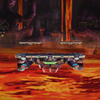 Norfair |
Different layout with two slowly moving platforms and all hazards removed. |  Norfair (Brawl) |
 Onett |
Cars cause much more knockback. | |
 Pictochat |
Some transformations removed. Some previously impassable platforms can now be passed through. |  Pirate Ship |
Hazards made weaker. | ||
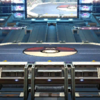 Pokémon Stadium 2 |
No stage transformations. Replaces Pokemon Stadium in v3.6, but still uses its own song list. Center platform has a Master Ball drawing, and small televisors at the background display "Project M". |  Pokémon Stadium |

|
Completely redone without scrolling. Neutral stage with a main platform and three smaller platforms in an unusual configuration. |  Rumble Falls (Brawl) |
 Saffron City HD |
No Pokémon spawn. Replaces Pokemon Stadium 2 in v3.6, but uses Pokemon Stadium's song list. It used to replace Spear Pillar in v3.5 and below. Received a visual upgrade in v3.6, based off how it appears in Pokémon FireRed and LeafGreen, along with it now having a day and night cycle. |  Saffron City |
 Shadow Moses Island |
||
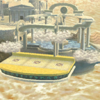 Skyworld |
Main platform made unbreakable and other platforms made into clouds. |  Skyworld (Brawl) |
 Smashville |
Replaces "Town Hall and Tom Nook's Store" with "Kick's Twilite Funk" and "The Roost" with "Title (Animal Crossing) Ver. M" | |
 Infinite Glacier |
Replaces Summit. Features two main platforms with icy properties connected by a trap door that occasionally opens, with several cloud platforms and one ice platform flying around. Also features the Balloon Fighter from Balloon Fight as a cameo in the background. |  Summit |
 Temple |
 Skyloft | |

|
Large stage with checkered surfaces, a wall at the left and a pit at the right, designed with a lot of open area for practicing. Features a sandbag that respawns in the middle when knocked out. Replaces Online Practice Stage. |  Wario Land |
Identical to WarioWare in Brawl, but with microgames removed and aesthetic changes made. Also replaces the song "WarioWare, Inc." with "Bad Mario". |  WarioWare, Inc. | |
 Yoshi's Island |
Platform ghosts now appear at predetermined intervals, with white Fly Guys signaling their appearance. Yoshi's Island (Melee) theme replaces Flower Fields |  Yoshi's Island (Melee) |
 Yoshi's Story |
No Fly Guys. Replaces Yoshi's Island (SSBM) Also replaces "Super Mario Bros. 3" theme with Yoshi's Story's and Yoshi's Island (Melee)'s theme with Yoshi's Island 64's. |  Yoshi's Island |
 Port Town Aero Dive |
 Luigi's Mansion |
||||
 Delfino's Secret |
Replaces Delfino Plaza and its theme. Used to be the Dracula's Castle stage from Castlevania, until v3.6 beta. |  Delfino Plaza |
 Bowser's Castle |
Replaces Mario Circuit and its theme. | Bowser's Castle (alternate competitive layout) |
 Jungle Japes |
 Spear Pillar |
||||
Turbo Mode
As of version 3.0, the Curry effect is replaced with a new one - Turbo. In Turbo mode, players are able to cancel any successful attack, upon hit or shield, into any other action except the same attack, and all aerial attacks auto cancel when landing if they hit. Certain moves, such as Farore's Wind, consist of multiple actions and can thus be canceled into themselves. Turbo Mode has been compared to the Marvel vs. Capcom series, because it enables skilled players to perform extensive combos.
Turbo mode can be selected from the Special Brawl menu, or temporarily granted by the "Turbo" item, which replaces Superspicy Curry. While in Turbo Mode, characters emit faint purple flame effects (compared to the red flame effects of Curry).
Notable Turbo-related resources:
- The official Turbo Mode blog post.
- Melee Impossible, the original inspiration for Turbo Mode.
- The official Turbo Tuesdays playlist, beginning with the April Fools video that revealed Turbo mode.
- Going Turbo, by Sethlon. The first Turbo combo video to feature no tool assisted inputs.
Tier list
The Project M developers did not publish an official tier list. On March 26th, 2014, CLASH Tournaments published a preliminary tier list for version 3.02, followed by a finalized tier list on November 14th, 2014. Mewtwo notably received then a perfect score of 10 out of 10, putting it in its own tier, the God Tier. Many fighters that generally did poorly in Melee and Brawl have seen large improvements in their Project M tier placings, such as Zelda going from the low tiers to the upper-mid tier.
No tier list was ever released for version 3.5, though it was generally agreed that only two characters could be considered "bottom tier". These characters were Olimar, whose recovery was too unreliable, and the Ice Climbers, who suffered from an unintended physics glitch (resulting in a very displaced pivot animation) that often caused Nana to self-destruct. As of version 3.6, Olimar has received a new recovery, and the glitch that plagued the Ice Climbers has been fixed.
On December 26th, 2015, a new tier list for version 3.6 was released, shown below.
| Project+ Official Tier List v4 [2.29] | ||||||||||||
|---|---|---|---|---|---|---|---|---|---|---|---|---|
| S | A+ | |||||||||||
| 1 | 2 | 3 | 4 | 5 | 6 | 7 | 8 | 9 | ||||
| 1.82 | 2.18 | 2.64 | 5.36 | 6.18 | 7.73 | 8.64 | 8.91 | 9.00 | ||||
| A | ||||||||||||
| 10 | 11 | 12 | 13 | 14 | 15 | 16 | 17 | 18 | 19 | 20 | ||
| 11.45 | 12.00 | 12.45 | 13.09 | 13.64 | 14.73 | 15.18 | 16.09 | 17.00 | 18.27 | 20.09 | ||
| B | ||||||||||||
| 21 | 22 | 23 | 24 | 25 | 26 | 27 | 28 | 29 | 30-31 | 32 | 33 | |
| 22.73 | 23.55 | 24.18 | 24.27 | 26.18 | 26.91 | 27.55 | 28.36 | 29.45 | 29.82 | 29.82 | 30.45 | 31.09 |
| C | D | |||||||||||
| 34 | 35 | 36 | 37 | 38 | 39 | 40 | 41 | 42 | ||||
| 34.36 | 35.09 | 35.27 | 35.64 | 35.73 | 37.18 | 38.82 | 40.27 | 41.09 | ||||
Release history
Demo 1.0
Released February 8, 2011
- 14 characters available
Demo 2.0
Released April 17, 2012
- Added 15 characters
Demo 2.1
Released May 23, 2012
- Major bug fixes.
- Skyloft is added, replaces Hanenbow.
Demo 2.5
Released December 29, 2012
- Added 4 characters
- Ledge teching implemented.
- Melee knockback stacking implemented.
- Input Assistance and Stock Control implemented.
- Input Lag from Brawl is fixed.
- New aesthetic changes which include new palette swaps and new menu designs.
Demo 2.5b
Released January 6, 2013
- Various Minor Bug Fixes.
Demo 2.6
Released July 17, 2013
- Added 1 character
The PMDT announced Project M 2.6 along with their new website design.
Demo 2.6b
Released August 15, 2013
- Various Bug Fixes.
v3.0
Released December 9, 2013
- Added 7 characters
- Turbo mode added.
- Princess Peach's Castle added, Norfair revamped, Distant Planet revamped, Training Room stage added.
- Numerous alternate costumes for several characters added, including Dr. Mario.
- Shedding of "Demo" title, now an official mod.
- Formerly, an April Fools' video[3] announced that 3.0 would contain a gameplay change where all moves would cancel into any other move/ action on hit. While the change being universal was a joke, it finally became available as a new "Turbo Mode" for Special Brawl, replacing the "Curry" option. Project M 3.0 also marks the first version to contain the entire Brawl roster, along with Roy and Mewtwo, and features many new alt costumes, such as Dr. Mario as an alternate skin for Mario, akin to Wario's biker and original skins. Other skins are: Melee Fox, Shadow Queen Peach, Ocarina of Time Link, Dry Bowser, Party Hat and Pirate Hat Pikachu, Crown and Fairy Jigglypuff, Armored Mewtwo, Mr. L, Virtual Boy R.O.B., Outset Toon Link, Classic Wolf, Boxer Donkey Kong, Pajama Ness, Masked Man Lucas, Fire Peach, additional Yoshi colors, Melee Falco, and Concept Art Meta Knight.
v3.01
Released January 11, 2014
- A new launcher is released with the following features:
- Support for SDHC cards larger than 2GB (Hackless method still limited to 2GB, unless Letterbomb is used).
- A news ticker will display current news for Project M which will update if the Wii is connected to the Internet.
- The ability to update and patch both the Launcher and the version of Project M. If 3.0 is installed on the SD card, the Launcher can automatically download and update to version 3.01.
- Faster and more reliable file loading.
- Fixed the lag from the imported models such as Roy, Mewtwo and the alternative costumes.
- Salty Runbacks implemented. Holding L+R+Y at the end of a match, or L+R+A+Y+Start at the pause screen, will cause the match to restart instantly. This feature is not available on Pokémon Stadium 1, Lylat Cruise, or Castle Siege. Similarly, it's possible to abort a stage loading by holding L+R+A, as in Melee, but faster loading times make this more difficult to perform.
- Various bug fixes, including (but not limited to) the following:
- Roy's Final Smash is reworked, and no longer causes game-breaking glitches.
- Many of Kirby's copy abilities updated.
v3.02
Released January 13, 2014
- Various bug fixes, including (but not limited to):
- WiFi codeset fixed to have the proper codes and menu descriptions
- Nana no longer disappears instantly on Norfair
- Jigglypuff, Ness, and Lucas no longer get stuck in water
- Giga Bowser causing crashes when on the Green Team has been fixed
- Squirtle, Yoshi, and Olimar now properly attack/roll on-stage when above 100% on Yoshi's Island (Brawl)
- The Random option under "Stage Choice" doesn't crash anymore
- Removed the color bars and caution signs from the character select portraits
v3.5
Released November 14, 2014
- SNES Captain Falcon, Smash 64 Falcon, Polar Bear Ice Climbers, Melee Zelda, Melee Sheik, Melee Ganondorf, Team Rocket Mewtwo, Fighting- and Steel-type Black Belt Lucario, sideways FRLG Red cap Pikachu, Ninja Squirtle, Armored Charizard, Fusion Suit Samus, Light Suit Samus, Dark Samus, Melee Samus, Classic Pit, Dark Meta Knight, Hector Ike, Sigurd Marth, Shadow Sonic, Tails Sonic, and Silver Sonic added as alternate costumes.
- Alternate team colors added for Donkey Kong, Wolf, Toon Link, Ganondorf, Ness, Dedede, Ike, and Marth.
- Metal Cavern, Hyrule Castle, and Dream Land have been given major graphical overhauls.
- The Subspace Emissary is now available, as it is mostly functional.
- Debug commands are added, which allow players to access features such as viewing hitboxes, hitstun, invincibility, pushboxes, and ledge sweetspots, halting the game and advancing it one frame at a time, fixing the camera at a specific location, and character switches on the fly.
- Screen KOs have been re-implemented, but the animation length has been changed to the same as Star KOs.
- Various character changes to adjust game balance, most especially to nerf recoveries and burst movement options that were seen as overpowered in previous versions.
- All-Star Versus mode is added.
- Reworked Stamina mode to allow for multiple stocks, normal knockback scaling rather than the set knockback of Brawl's Stamina Mode, and "world wrap lines" to replace the standard blast lines.
- Rotation mode now works with Roy, Mewtwo, and alternate costumes.
- Several Event matches have been revamped, moved, or replaced, either to add in popular Melee happenings such as The Showdown and the Bowser Challenge, or out of necessity due to the event scenario centering around a now-removed stage (such as Super Bowser Bros.).
- Squirtle, Ivysaur, and Charizard have all been given functional Final Smashes of their own.
- Jungle Japes has been removed completely.
- Hanenbow revamped to be more suitable for Turbo Mode.
- The Summit replaced with Infinite Glacier.
- Impact font replaces Brawl's font in the menus.
- In v3.0, Mewtwo's and Roy's voices were added by overwriting those of Galleom and Duon respectively, resulting in atypical sound effects when fighting either boss; this was fixed in v3.5 by now having the characters share voices with their clone engine counterparts.
- In v3.0, the Timer item would cause highly atypical momentum behavior when activated[4]; this was fixed in v3.5.
v3.6β
Released June 24th, 2015
- The addition of 0 To Death Mode (labeled in-game as "Regen Mode" to fit the available space in the Special Versus box), in which a player's damage is reset when they escape from a combo.
- The option to have automatic L-canceling.
- New announcer
- The return of several Brawl stages such as Luigi's Mansion and Spear Pillar.
- HD remake for Saffron City and Peach's Castle.
- Alternate Stage loader by holding L+A buttons on stage select (accesses new stages such as Delfino's Secret; past stages such as Planet Zebes, N64 Yoshi's Island, Sector Z and the Melee version of Battlefield (some stages like Pokémon Stadium will be an ASL for Pokémon Stadium II to make room for returning Brawl stages.) and the Brawl versions of updated stages like Summit, Distant Planet and Green Hill Zone.)
- Removal of Dracula's Castle (which is, in turn, replaced by Delfino's Secret) due to legal reasons, as well as the removal of Princess Peach's Castle and Rainbow Cruise.
- New music for Smashville, Metal Cavern, and the newly added stages.
- A new black Armored Charizard recolor, Mr. L recolors, an orange recolor for Diddy Kong, a revamped red Pit color, Classic Dark Pit, Mario Kart DS ROB, Wii ROB, Dark Suit Samus, as well as graphical upgrades for some of Samus, Meta Knight, and Zero Suit Samus's costumes from 3.5.
- Various bug fixes (notably, the bugs and glitches that plagued Olimar and the Ice Climbers in 3.5).
- A new Bowser's Castle stage.
- A new Delfino's Secret stage.
v3.6
Released August 16th, 2015
- New announcer replaces the previous one from the beta.
- WarioWare revamped into a Wario Land themed stage, with the original Brawl version available as an alternate stage.
- The return of Rainbow Cruise and Bridge of Eldin as alternate stages for Peach's Castle and Hyrule Castle, respectively.
- Only applying to the latter two stages, players have access to "Hidden Alternate Stages" by holding the Z button. This accesses the N64 versions of Peach's Castle and Hyrule Castle.
- A competitive version of the Bowser's Castle stage added as an alternate stage.
Errors
Despite having numerous updates over time, Project M currently experiences some minor errors outside the regular Versus modes, due to the mod's focus on the competitive aspect of the game over single-player aspects.
- For the same reason that a Wi-Fi-safe version of the mod exists (with fewer features to prevent online desynchronization), replays often become corrupted or fail to work properly.
- If Brawl replays are played on Project M, and the replay goes past its time limit (due to corruption), the game will simply fast forward the replay until a definitive end (i.e., running out of time, quitting out of the replay).
- Fixed-camera mode is completely dysfunctional on numerous stages, often by being off-center, such as on Yoshi's Story or Hyrule Castle; on some stages, the player can even see the transition from hitting the upper blast line to a Star KO.
- Because of flaws involving Roy and Mewtwo's assets, as well as those of new alternate costumes, the mod freezes when players try to access Tournament Mode.
- Roy's and Mewtwo's voices can still be heard while they are metal.
- Though the Pokémon Trainer's Pokémon will still have records saved for him, they cannot be viewed unless Brawl itself is booted.
- In events that allow choosing any character, choosing Mewtwo or Roy will make the game think that Lucario or Marth, respectively, have been chosen in terms of deciding whether to apply an alternate costume to an opponent.
- Because Sheik, Zelda, Samus, and Zero Suit Samus have individual character slots, this can give two players the same palette swap if the corresponding characters transform into each other.
- There are a few glitches that exist with the debug commands:
- The debug toggle and its commands can be activated at any point during the game, including the menus, though the player will only see the effects of the frame advance commands.
- If the character switch command is used with an alternate costume, there is the potential for no character to appear once the switch has been made. This is due to some characters not having their own alternate costume (for example, switching to Diddy Kong from Captain Falcon wearing his classic costume will cause no character to spawn at all because Diddy Kong does not have an 8th palette swap like Captain Falcon does). Attempting to exit out of a match while this glitch is in effect will freeze the game. The character switch command will also not work properly in stadium game modes or one-player modes.
- In All-Star Versus, if the winning character is KO'd at the end of the match and has a different character in their next stock, the results screen will show the next character, but announce the name of the character that was KO'd.
Downloading instructions
The mod can be downloaded here and requires only a SD card, non-PAL Wii or Wii U, and a non-PAL Brawl disc.
Hackless Method:
<youtube>v1THCfP8Rpo</youtube>
Homebrew Method:
<youtube>Y_-brk7b5qI</youtube>
Developers
The team has dissolved after the ending of development of Project M, but they are of course still credited.
- Project Leaders: SHeLL, Magus, Strong Bad, jiang, Shadic, haloedhero, Yeroc, Shanus
- Playtesters: Historically, the PMDT has had playtesters such as Hungrybox, Mango, Lucky, KirbyKaze, aMSa, and many more. The last playtester team before the end of development consisted of Gimpyfish62, TheReflexWonder, Fuzzyness, Professor Pro, Fly Amanita, Jolteon, and many, many others.
- Graphics/Menu Design: FireBall Stars, ds22
- Animation: haloedhero, Ztilb, SiLeNtDo0m
- Stage Design: Mewtwo2000, Shadic, Vanguard, SOJ
- Sound Team: Pete "Phonetic Hero" Lepley, Garrett Williamson, Riddlr
Response from Nintendo
Nintendo has not given an official response to Project M; however, it is largely assumed that the company does not approve of the mod. One policy Nintendo has taken has been issuing bans for mentioning Project M by name on any of Nintendo's Miiverse channels, because it allegedly constitutes "criminal activity". This includes using the abbreviation "PM", which can result in erroneous bans when talking about other games or series with the same abbreviation (such as Paper Mario, although this is allowed on the Paper Mario Community), or when used for miscellaneous purposes (such as denoting the daily time-span between noon and midnight).
In October 2014, it was announced that Project M would be dropped from the lineup of Apex 2015, with many qualifying tournaments also suspending their Project M events. While some qualifiers did feature Project M tournaments, no official online streams were available for such events apart from B.E.A.S.T 5 which was streamed on VGBootCamp; commentators on streams provided by VGBootCamp were also reportedly instructed to not mention Project M while on air. As Nintendo had previously begun involving itself with the competitive community, such as through the Super Smash Bros. Invitational at E3 and a video presentation from Nintendo of America's president Reggie Fils-Aimé at the conclusion of EVO 2014, it was strongly suspected this was due to Nintendo being involved with the event. It was later announced in January 2015 that Apex had officially partnered with Nintendo for Apex 2015, giving credence to this theory.
Since Apex 2015, many major tournaments have dropped Project M from their game rosters. In addition, VGBootCamp, which became well known for popularising the mod, later announced that they would no longer stream PM, and subsequently removed all PM content on their channel. All of these are generally attributed to either behind-the-scenes intervention by Nintendo or fears of encountering legal issues for featuring the game.
As of December 1, 2015, the Project M Development Team ultimately decided to conclude developing the mod, shutting down their official page and removing the download links from the site, leaving a farewell message on the main page where the developers feel their work and last version of Project M complete and therefore pursue original ventures. Reasons for the conclusion weren't clearly specified, but according to a tweet, legal issues were not the cause with the cease of the mod. Later on, a statement from a former member of the development team explained that it was a preemptive measure for fear of potential legal issues against Nintendo in the future, in which the team voluntarily finished the development of Project M altogether.
Trivia
- Project M coincidentally shares its name with the development team of Metroid: Other M, which was a team of over 100 people, including staff from Nintendo, Team Ninja, and D-Rockets.
- Since 2014, the Project M main site has posted fake news announcements to its news blog on April Fools' Day.
- As mentioned above, Turbo Mode was announced in 2013. At the end of the video, it implied that Pichu would be playable.
- In 2014, it announced the Ike Climbers, who ostensibly would be a hilariously broken character composed of 2 Ikes paired up into one character like the Ice Climbers (apparently portrayed in the video by 2 Ikes with model hacks on a team with friendly fire off), and Slippy, ostensibly a useless joke character who couldn't do anything but get beat up (apparently portrayed in the video by a Fox with a model hack). At the end of the video, it implied that Ridley would be playable.
- In 2015, they announced that they would be porting Project M to the Nintendo 64. The video appears to have been made by replacing all the models in the game with low-poly counterparts (the "perfect attendance crew" using their models from the original game itself, and all other characters using custom models or models from other retro systems), and either replacing in the game or overdubbing in the video many of the sound effects with counterparts from the original Super Smash Bros. The video was overlayed with humorous sound effect bubbles parodying those from Super Smash Bros.' official artwork. At the end of the video, similar to the previous year, it implied that Parasect would be added to the roster, as a reference to the number 47 that has secretly appeared in past videos (Parasect is Pokémon #47 in the Pokédex).
- Interestingly, most of the fake content announced (such as Turbo mode and past stages) have actually been added into builds of Project M.
References
External links
- Official Project M Website (Only the indefinite suspension of development announcement is currently present.)
- The Project M forum
- Project M subreddit
- Project M YouTube channel
| Playable characters in Project M and Project+ | |
|---|---|
| Playable characters | Bowser (Giga Bowser) · Captain Falcon · Charizard · Diddy Kong · Donkey Kong · Falco · Fox · Ganondorf · Ice Climbers · Ike · Ivysaur · Jigglypuff · King Dedede · Kirby · Knuckles · Link · Lucario · Lucas · Luigi · Mario · Marth · Meta Knight · Mewtwo · Mr. Game & Watch · Ness · Olimar · Peach · Pikachu · Pit · R.O.B. · Roy · Samus · Sheik · Snake · Sonic · Squirtle · Toon Link · Wario (Wario-Man) · Wolf · Yoshi · Zelda · Zero Suit Samus |


